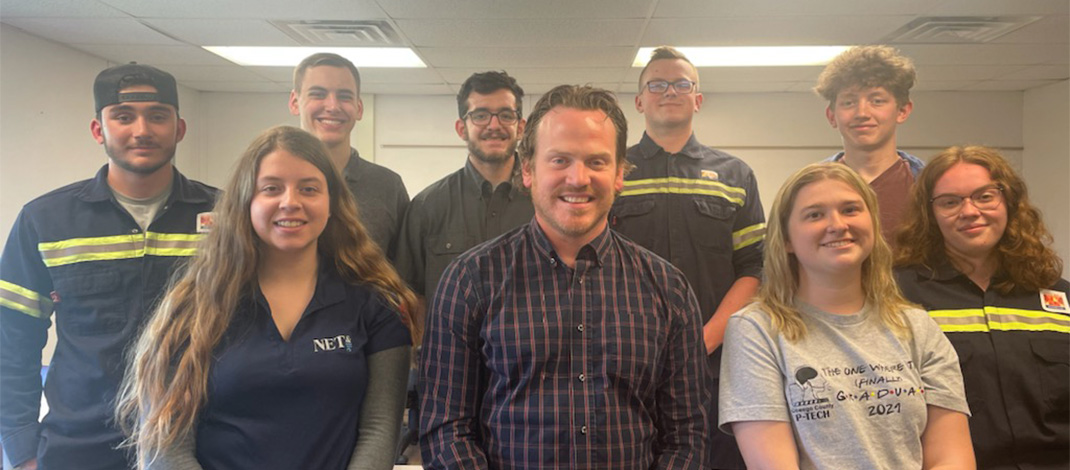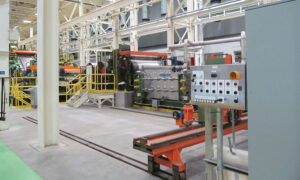By Steve Yablonski
Program has seen records number of applicants: 24% of them female. Graduates earn on average $56,000 after they get employment
The Oswego County P-TECH program provides students a high school Regents diploma, a cost-free associates degree and workforce development programming for those interested in pursuing career pathways in the field of advanced manufacturing.
Operating since 2016, P-TECH — Pathways in Technology Early College High School — is a collaborative partnership between K-12 school districts, Onondaga County Community College and local manufacturing facilities. Freshman students from nine school districts in Oswego County are eligible to apply to the program and have up to six years to complete requirements.
“The program was designed to provide a direct pathway for students to enter the workforce with middle class jobs and a college degree that would assist in fulfilling an anticipated workforce gap in the field of advanced manufacturing due to anticipated growth in manufacturing along with an aging workforce,” P-TECH principal Brian Heffron said.
It gives students a pride and ownership of finding a lucrative career in Oswego County where they could grow families and contribute to local economies, he said.
There are about 38 P-TECH programs around the state currently. It started in a Brooklyn high school. The model was a partnership between higher education and industry to serve students, to help them transition from high school, through college and into industry.
In 2021, the program had 10 graduating students with a cost-free college degree in electric or mechanical technology from Onondaga Community College and entering full-time employment in manufacturing facilities throughout Oswego County and Central New York.
In May of 2022, 23 students graduated from the program; 15 have already accepted full-time jobs or internship in facilities such as Huhtamaki, Novelis, Davis-Standard, Lockheed Martin, Carrier and more, Heffron said.
“With students continuing to interview with our partners, we’re on track to meet our goal of having 100% of our graduating class enter the workforce immediately upon graduation,” he added.
The jobs students are entering into from the program range from production to lab to mechanical or electric technicians. Pay rates for starting salaries range from $20 per hour to $33 per hour. This puts the average starting salary for P-TECH graduates north of $56,000 per year, according to Heffron.
Keep in mind, students graduate from the program with zero school debt, he pointed out.
“Oswego County P-TECH graduates are choosing to live and work in our county to launch their careers, contribute to their local economies and put an end to false narrative that one must leave Central New York to chase opportunity,” Heffron said.
The program’s strong relationship with Onondaga Community College has resulted in students experiencing academic success in college and graduating earlier then compared to the national averages. Students in P-TECH are not taking remedial classes; they’re entering credit-bearing coursework as early as 10th grade.
More than 35 mentors, representing 12 different manufacturing facilities in the region, are meeting frequently with students beginning in ninth grade and providing critical guidance that is steering students toward success in the classroom and in the jobsite.
The industry partners don’t just sign on and say, “We support the program.”
“They are boots on the ground, actively involved and helping the students succeed,” Heffron said.
Recruitment
The program is coming off one of its most successful recruitment years. More than 90 students toured the facilities of industry partners over the past winter and 70 applications have been submitted.
Of the students who applied to the program this year, 24% are female students, Heffron said.
“I project that student interest in the program will continue to grow as the stories of our students successfully graduating and entering middle class jobs reach other students, parents and our local community leaders,” Heffron predicted.
Women make up only 28% of the workforce in science, technology, engineering and math.
“Collaborating with our school districts, local industry and Onondaga Community College, we have set our goals on increasing female representation in the program. That work goes beyond attracting, recruiting and retaining female students to our STEM pathway,” Heffron said. “To close the STEM gap, we have teamed up with our partners in outreach activities that aim to send the message that girls are as capable as boys.”
This includes working with parents to encourage their daughters to pursue programs such as P-TECH.
“We must do a better job connecting students with role models who students can see themselves in becoming,” Heffron explained. “That is what is exciting about P-TECH. Our female graduates who now work in the manufacturing facilities are returning to the program to mentor a new generation of diverse talent. As one of our recent female graduates said, ‘Seeing was believing.’”
P-TECH financial sustainability
The P-TECH program is funded through a New York State Education Department grant and shared costs amongst the county’s nine component school districts. Its first grant cycle started in 2016 and ends at the conclusion of the 2021-2022 school year. However, it recently received permission by NYSED to apply for renewed funding that will run through 2028.
“We have been collaborating hard with our local leaders and other agencies to find additional ways to provide support to ensure the program can grow and meet the demands of our local manufacturing industry which continues to project a growing gap in workforce needs and availability of skilled applicants in our region,” Heffron said, adding, “I’m hoping to spend less of my days explaining what P-TECH is to our local leaders and shift the narrative to how P-TECH can grow in its role as an economic engine for our region.”




